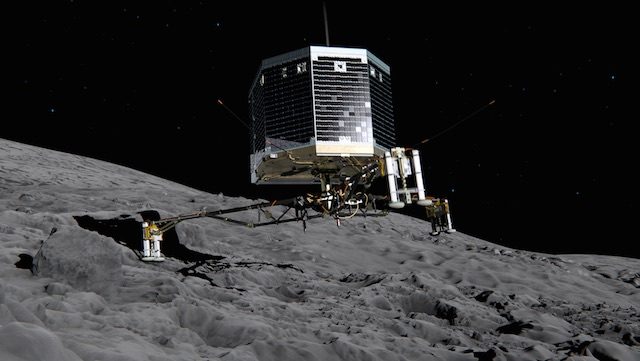SUMMARY
This is AI generated summarization, which may have errors. For context, always refer to the full article.

PARIS, France – The European space probe Philae woke up overnight after a months-long sleep as it hurtled towards towards the Sun on the back of a comet, the French space chief said Sunday, June 14.
“We received new signals from (Philae) for a period of two minutes, as well as 40 seconds’ worth of data,” Jean-Yves Le Gall, president of the National Centre for Space Studies (CNES), told Agence France-Presse.
“Hello Earth! Can you hear me?” the tiny robot lab tweeted under the hashtag #WakeUpPhilae.
Europe launched a new bid in May to communicate with Philae via its mothership Rosetta, which is in orbit around Comet 67P/Churyumov-Gerasimenko.
Their exploration aims at unveiling secrets of comets – pristine bodies of ice and dust that are believed to explain how the Solar System was formed.
The 100-kilogram (220-pound) robot lab touched down on “67P” on November 12 after a 10-year trek piggybacking on Rosetta.
But instead of harpooning itself onto the dusty iceball’s surface, Philae bounced several times before settling at an angle in a dark ditch.
The little lander had enough stored battery power for around 60 hours of experiments, and sent home reams of data before going into standby mode on November 15.
As “67P” drew closer to the Sun, scientists hoped better light would recharge Philae’s batteries enough for it to reboot, then make contact, and ultimately carry out a new series of experiments.
“Philae has woken up at 13 June 2228 Central European Time,” the European Space Agency (ESA) spokesman Pal Hvistendahl told Agence France-Presse.
Comet 67 is currently 215 million kilometers (134 million miles) from the Sun and 305 million kilometers from Earth, racing at 31.24 kilometers a second, according to ESA’s website.
Rosetta and Philae have travelled an accumulated distance of 6.9 billion kilometers, it said.
By August 13 the comet will reach its closest point to the Sun, or perihelion, before veering off again into the deeper reaches of space. – Rappler.com
Add a comment
How does this make you feel?
There are no comments yet. Add your comment to start the conversation.